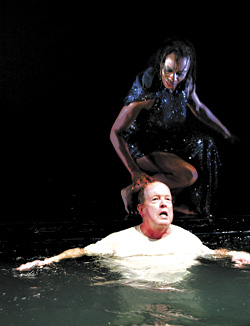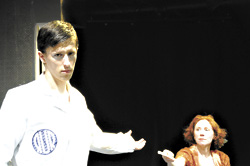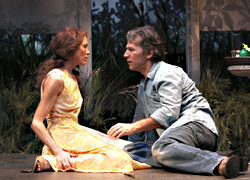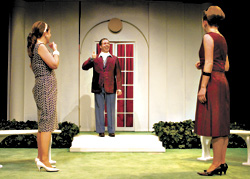One of the main protagonists in The Breach, a play about the devastation wrought by Hurricane Katrina, is water. Water, water everywhere, and not a drop to drink, as one of the very human characters intones. Written by Catherine Filloux, Tarell McCraney, and Joe Sutton, and directed for Seattle Rep by artistic director David Esbjornson, this “story about the drowning of New Orleans” is a boldly surreal examination of the ordinary lives that were disrupted and forever changed by that deluge. Hardly a comprehensive document of that tragedy (for that see Spike Lee’s When the Levees Broke), The Breach follows three separate story lines, burrowing into intimate personal experience to draw the universal from the specific.
Considering all that’s been said and represented about Katrina, this would seem the right approach—one that seeks to build empathy at the gut level, that belies the gush of statistics and mass media’s brief, big-picture perspective. Oddly enough, however, The Breach fails at just that level. Interesting, impressively spectacular, and artistically ambitious, the Rep’s production is a monumental effort that includes a pool containing 840 cubic feet of water, buckets of rain falling from the rafters, and lots of moving parts onstage. And therein lies the problem. One feels the playwrights were shooting for Chekhov, but they got Bruckheimer instead.
The stories themselves, which progress in brief, intersecting interludes, are well-honed and compelling, offering what seems a fairly representative cross section of those most affected by the storm. There’s an African-American extended family—brother, sister, and grandfather—first seen climbing frantically onto their roof to escape the rising flood. This bickering but tight-knit clan—Severence (Hubert Point-Du Jour), Quan (Michelove René Bain, a fourth-grader at St. John School), and the grouchy patriarch, Pere Leon (William Hall, Jr.)—spend the entire play marooned on the rooftop, arguing, sleeping under plastic, and otherwise avoiding the raging torrent at their feet. This segment of the narrative triptych is told partly as a flashback by the older Quan (Crystal Fox), a woman steeped in the bitter wisdom of loss.
In the second story line, stage and screen veteran John Aylward plays Mac, a wheelchair-bound New Orleans native who defiantly disobeys the government’s evacuation notice—having already “dodged three bullets” in the city’s hurricane-heavy past—only to be literally swept away by the rushing waters. Mac, the father of (Saint) Francis, a Gulf War veteran (Kelly Conway), is haunted by the image of lost love. And not only that: As the current carries Mac relentlessly toward the swallowing Gulf of Mexico, he is hounded by the spirit of Water herself (Nike Imoru), a gorgeous temptress who by turns mocks and seduces her ward like a Greek siren, filling him with “the language of drowning.” In the play’s third and least successful installment, Lynch (Michael Braun), an out-of-town reporter, attempts to get to the bottom of a widespread conspiracy theory that says the levees were intentionally blown up by, you know, “them.” As Lynch tries to penetrate the deepest recesses of New Orleans fringe society, he encounters an intriguing but highly resistant band of insiders, including the charismatic Aunt Sis (Michele Shay).
“When will people realize that water always has the last word?” This line, spoken near the end of The Breach by one of the survivors, could just as well be said of the play itself. The cast is excellent, the writing is edgy and daring, and the play’s jump-cut structure keeps things moving at a clip without belittling the tragedy’s enormity—which, after all is said and done, was about the slowly ticking minutes, hours, and days during which a failure to respond became an egregious crime against humanity (how many is that now for Bush le Petit?). But just because one can build a 6,000-plus-gallon pool at the front of the stage doesn’t necessarily mean one should, especially when that giant tub distracts from the urgency of the drama at hand. Had this been a different play—one not moving in so many directions at once, one with a more unified and straightforward narrative—such grand production values might have been more fitting. But, given the script’s pyrotechnics, all that water works to distract and, in the end, douse the flame of inspiration. The play is not a bust, and it’s anything but dull. It’s just that it could have been so much better, so much more. And therein resides the timeless lesson, one that kids and poor people and fringe theaters have to learn by necessity: Forced by circumstance to innovate, the imagination flourishes.








